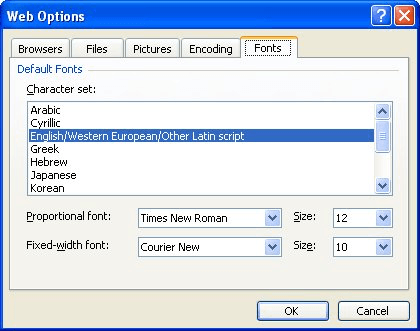Please Note: This article is written for users of the following Microsoft Word versions: 2000, 2002, and 2003. If you are using a later version (Word 2007 or later), this tip may not work for you. For a version of this tip written specifically for later versions of Word, click here: Setting Web Fonts.
Word includes many features designed to make it work well with the Web. (Well, it included them starting with Word 2000 when Microsoft finally woke up to the Internet.) One such feature allows information to be saved in a Web-page format. This means you can create Web pages with Word, if desired.
The Web is a more limited environment than you may be used to in Word. One such area of limitation is in the fonts that are used. Typically, Web pages are constructed of one or two fonts, not the hundreds that are possible with Word. You can set the default fonts that Word uses when constructing Web pages by following these steps:

Figure 1. The General tab of the Options dialog box.

Figure 2. The Fonts tab of the Web Options dialog box.
WordTips is your source for cost-effective Microsoft Word training. (Microsoft Word is the most popular word processing software in the world.) This tip (57) applies to Microsoft Word 2000, 2002, and 2003. You can find a version of this tip for the ribbon interface of Word (Word 2007 and later) here: Setting Web Fonts.

Do More in Less Time! An easy-to-understand guide to the more advanced features available in the Microsoft 365 version of Word. Enhance the quality of your documents and boost productivity in any field with this in-depth resource. Complete your Word-related tasks more efficiently as you unlock lesser-known tools and learn to quickly access the features you need. Check out Microsoft 365 Word For Professionals For Dummies today!
If you have a document that contains hyperlinks to a PDF file, it is possible that the links may not open the PDF file ...
Discover MoreWant to build a Web page using Word? Here's an overview of how it works.
Discover MoreConvert those URLs into regular text! It's easy to do when you follow the steps in this tip.
Discover MoreFREE SERVICE: Get tips like this every week in WordTips, a free productivity newsletter. Enter your address and click "Subscribe."
There are currently no comments for this tip. (Be the first to leave your comment—just use the simple form above!)
Got a version of Word that uses the menu interface (Word 97, Word 2000, Word 2002, or Word 2003)? This site is for you! If you use a later version of Word, visit our WordTips site focusing on the ribbon interface.
Visit the WordTips channel on YouTube
FREE SERVICE: Get tips like this every week in WordTips, a free productivity newsletter. Enter your address and click "Subscribe."
Copyright © 2025 Sharon Parq Associates, Inc.
Comments